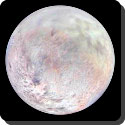 When a satellite, natural or artificial, is orbiting its parent planet (or primary) under some conditions, the satellite revolves around itself (or spins) quite fast relative to its period of rotation around the primary, and under some other conditions, both the periods coincide. The latter phenomenon leads to the satellite facing the primary always with the same side and it is called captured rotation or synchronous rotation. It occurs especially when the satellite is much smaller than the primary, and the two are separated by a relatively short distance. In the solar system, the moon and some inner moons of Jupiter experience captured rotation.
When a satellite, natural or artificial, is orbiting its parent planet (or primary) under some conditions, the satellite revolves around itself (or spins) quite fast relative to its period of rotation around the primary, and under some other conditions, both the periods coincide. The latter phenomenon leads to the satellite facing the primary always with the same side and it is called captured rotation or synchronous rotation. It occurs especially when the satellite is much smaller than the primary, and the two are separated by a relatively short distance. In the solar system, the moon and some inner moons of Jupiter experience captured rotation.
Check Also
साप्ताहिक लव राशिफल मई 2025: ऐस्ट्रॉलजर नंदिता पांडेय
साप्ताहिक लव राशिफल 28 अप्रैल – 04 मई, 2025: आइए जानते हैं ऐस्ट्रॉलजर नंदिता पांडे …
 Kids Portal For Parents India Kids Network
Kids Portal For Parents India Kids Network






